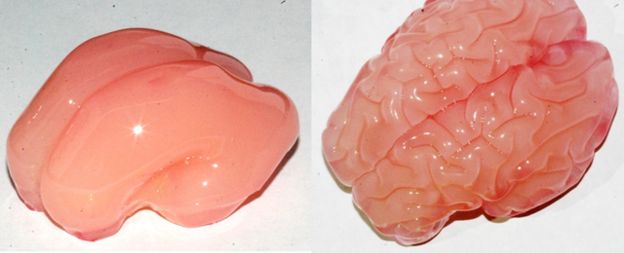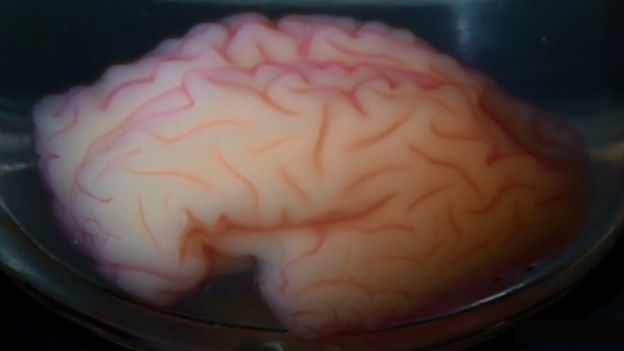- 1 February 2016
- Science & Environment
출처: http://www.bbc.com/news/science-environment-35438294
Physics of brain wrinkles copied in a jar 주름진 뇌의 물리현상이 유리 안에서 재현되다
In a glass jar, 12 weeks of foetal brain development were mimicked in 20 minutes (Footage: Mahadevan Lab/Harvard SEAS) 12부주 태아의 뇌발달 모습을 20분간 유리잔 안에서 흉내내어 보았다
Scientists have reproduced the wrinkled shape of a human brain using a simple gel model with two layers.
They made a solid replica of a foetal brain, still smooth and unfolded, and coated it with a second layer which expanded when dunked into a solvent.
That expansion produced a network of furrows that was remarkably similar to the pattern seen in a real human brain.
This suggests that brain folds are caused by physics: the outer part grows faster than the rest, and crumples.
Such straightforward, mechanical buckling is one of several proposed explanations for the distinctive twists and turns of the brain's outermost blanket of cells, called the "cortex".
Alternatively, researchers have suggested that biochemical signals might trigger expansion and contraction in particular parts of the sheet, or that the folds arise because of stronger connections between specific areas.
"There have been several hypotheses, but the challenge has been that they are difficult to test experimentally," said Tuomas Tallinen, a soft matter physicist at the University of Jyväskylä in Finland and a co-author of the study, which appears in Nature Physics.
"I think it's very significant... that we can actually recreate the folding process using this quite simple, physical model."
 Tallinen et al/Nature Physics
Tallinen et al/Nature PhysicsHumans are one of just a few animals - among them whales, pigs and some other primates - that possess these iconic undulations. In other creatures, and early in development, the cortex is smooth.
The replica in the study was based on an MRI brain scan from a 22-week-old foetus - the stage just before folds usually appear.
A 3D printout of that scan was used to make a mould, which in turn was filled with a silicon-based gel to make the "gel brain".
Finally, a 1mm-thick layer of slightly different gel was added to the surface - to play the role of the cortex.
Distinctive grooves
When placed in a glass jar full of an organic solvent for 20-30 minutes, this outer layer swelled up and contorted itself into a very familiar shape.
"When I put the model into the solvent, I knew there should be folding but I never expected that kind of close pattern compared to human brain," said co-author Jun Young Chung from Harvard University, US.
"It looks like a real brain."
Specifically, the shape and direction of the gel brain's major grooves were an excellent match to those found in a typical 34-week-old human brain.
 Mahadevan Lab/Harvard SEAS
Mahadevan Lab/Harvard SEASThe team also created a computer simulation of the process.
Starting with the same shape as the replica foetus brain, split into its two simple layers, this mathematical model allowed them to follow the expansion process much further - until the simulated brain reached adulthood.
"In real brains there's something like a 20-fold increase in cortical area during development," Dr Tallinen told the BBC. "We can't create that in physical model - but in the numerical model we can. And we can also use more realistic parameters."
The experiments were a continuation of previous research by the same team, in which they stuck an expanding layer onto a simple spherical shape and calculated the stiffness and depth of "cortex" that produced wrinkles of a brain-appropriate size.
"In this paper we use real brain geometries, and we reproduce a developmental setting," Dr Tallinen explained. "We can study how brain geometry affects folding and creates the kind of arrangements of folds that we see in human brains."
 Tallinen et al, Nature Physics
Tallinen et al, Nature PhysicsAs for whether these findings clinch the argument for brain folding being a purely mechanical process, Dr Tallinen was circumspect.
"The things that we saw in our model will inevitably happen in real brains as well, just as a consequence of this simple expansion. But there could be some other biological factors that modulate this process."
Abnormal folding
Zoltan Molnar, a neuroscientist at Oxford University who studies cortical development, said this was an impressive study that reconciled different ideas about how the brain folds, using a simple model.
"It's an excellent start - and it's almost alarming how similar it looks!" he told BBC News.
The simplicity of the mechanical mechanism is appealing, Prof Molnar explained, because it helps explain why "almost every branch" of the evolutionary tree has some species with brain folds, and some without.
"It has to be quite simple, because evolution is not going to keep inventing things twice. This way, you can see why it's so common."
The work also holds promise, he added, for studying diseases in which the brain fails to fold in the usual way.
"If they could recreate [a disorder] by changing some of the parameters... that would really help us to understand some of these folding abnormalities."
'과학과 테크놀로지 > 과학' 카테고리의 다른 글
| (과학) 아인슈타인의 중력파 관측되다 (0) | 2016.02.12 |
|---|---|
| (과학) 말도 사람의 감정을 알아차린다 (0) | 2016.02.10 |
| (과학) 천문학자들 최대 태양계 발견 (0) | 2016.01.29 |
| (과학) 은하계 역사를 추적하는 '연대 지도' (0) | 2016.01.10 |
| (과학) 어떻게 화학자들은 폭발물을 찾아내고자 하는가? (0) | 2015.12.28 |
